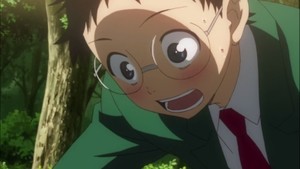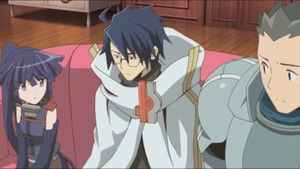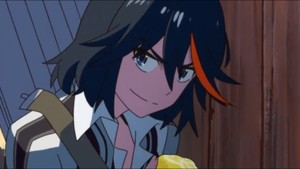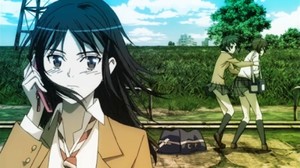The Fall 2013 Anime Preview Guide
Bamboo Dong
Bamboo Dong is the managing editor at ANN. She enjoys New Belgium Brewery, miniature goats, and rolling her eyes at people who use mason jars for non-canning purposes.

Unbreakable Machine-Doll
Rating:2.5
Japanese puppeteer Raishin Akabane has come to the Walpurgis Royal Academy of Machine Arts in England with his cute (naturally) and slavishly devoted (of course) automaton, Yaya. Although in real life, a puppet school would probably be populated only by weirdos, this school is chock full of lean, mean fighters who train their magical machine dolls in combat. Raishin has come to the school to seek revenge against one of the other students. Meanwhile, his sweet, not-so-innocent machine doll Yaya just wants to canoodle with him and "let [him] use [her]!"... in ways that don't just involve combat.
I can't help but think that Unbreakable Machine-Doll would be infinitely better without the semi-cute, semi-sinister, one-sided automaton flirting. Can't we have one show without some cute girl (human or not) flinging herself at the hero? It's especially weird and kind of uncomfortable when the guy keeps telling the girl the stop and to leave him alone, but she nevertheless keeps doing it (because, as the logic goes, what viewer wouldn't want a cute girl continually plotting ways to get in the sack with him?). Combined with her insistence that she exists for him (which, yes, she is a robot made for such things), it makes for this stilted relationship (if you can call it that?) that would be totally gross, if it weren't continuously emphasized that the girl is just an automaton. It's not weird if she's not real, right?
Bizarre, one-sided relationship aside, Unbreakable Machine Doll seems to otherwise straddle that line between plain and mildly interesting. The fact of the matter is, we haven't had enough time to actually 1) learn what these automatons are and what (if any?) rules they operate by and 2) learn more about any of the characters other than knowing that Raishin's got a blood grudge out against one of the other students. It certainly has the possibility of becoming an interesting show if done correctly, but it's a little too early to tell.
For now, I can't seem to get rid of the bad taste in my mouth that all the automaton-flirting left. It just seems like an unnecessary means to shoe-horn in... what, cute girls doing... oh-so-original flirtsy-poo things? It almost doesn't qualify as fanservice, it's so forced and awkward. Whatever it is, the series doesn't need it.
Unbreakable Machine Doll is available streaming on Funimation.com.

Gundam Build Fighters
Rating:2.5
Gundam Build Fighters is incredibly meta, and one almost has to respect Sunrise and Bandai for saying, "Yup, we make toys, and we know you'll buy them no matter what we do or say. Please buy one on your way out." I mean, for decades, the Gundam franchise has been virtually synonymous with plastic Gundam models (or GunPla, as they're called for short). Sure, the various iterations of anime have been ground-breaking in their own ways, and continue to do well with every release-- but the associated GunPla market does even better. For every single mech that's ever been animated in the Gundam franchise, a GunPla exists, in different variations, different scales, different grades, with different weapons and add-ons. The Gundam franchise as it already is exists to sell toys.
And now, that has come full circle with Gundam Build Fighters, which is literally a show about Gundam fans who buy and build GunPla models, and pit them against each other in virtual arenas (that still somehow do actual battle damage). The show is so unapologetic about its whoring of Gundam kits that the main character works in a Gundam store, talks about Gundam models... and the eye-catches for the series feature actual, real-life kits. But hey, if you reeeeally need a call-back to the franchise (that isn't molded from plastic and snapped together), the super talented GunPla fighters are even called... yup, Newtypes.
Quite honestly, I'm okay with it. Look, if you want an original Gundam story, with new Gundams, with new pilots, and actual situations, just wait around for a little while, and Sunrise will release one. They make new Gundam shows like Doritos makes new chip flavors. There will never be a shortage of actual Gundam shows. Gundam Build Fighters is a brawler, plain and simple. It's the Marvel vs. Capcom of the snap-kit world, if MvC let you swap out Cable's guns for different weapons, and upgrade Psylocke's abilities. Hell, it's the Gundam VS of the Gundam world. And of course Gundam Build Fighters is being made to sell even more Gundam kits-- part of the reason the characters can even trick out their kits is so that real-life consumers will buy the customizable HG Build Fighters line of models (with optional HG Build Custom accessories, obviously).
I don't know. Maybe I'm defending this series so strongly because I know that deep down, it's not that great of a show. I mean, if I'm really being honest with myself, yeah, the premise is really stupid, and the inclusion of the weird deus ex machina mystery boy Reiji is really stupid. Yeah, right, some mysterious entity is going to use his power to help you smash up other people's toys.
But at the same time, I kind of like the mindless spectacle of just seeing random Gundams go at each other. I mean, isn't this why people like cross-over fighting games? Isn't it kind of how hundreds of thousands of people can let their lives melt away just staring at SaltyBet all day?
Even as I type this, I feel a little dirty inside, because I know that I'm letting my blind love of Gundam get to me. I know that, when the virtual anime e-beers wear off, and the novelty has worn off, I'll admit to myself, "Yeah, this show is a giant toy commercial, with really annoying characters, and a really pathetic excuse for a plot." But today's not that day.
Gundam Build Fighters is available streaming at Gundam.info.]

Non Non Biyori
Rating:3
From the opening scene, when we first see adorable first-grader Renge walking to the bus stop, tooting out a shaky, almost-in-tune rendition of the theme on her recorder, Non Non Biyori is mind-bogglingly cute and genuinely funny. The series takes place out in the countryside, in a sleepy farm village that doesn't even have convenience stores. All of the kids in town (there are four at the beginning) go to class in the same room, and their busses only run once every two hours.
In comes Hotaru, a transfer student from Tokyo who's a little daunted and confused by suddenly being plopped into the boonies, but she's willing to try new things and make friends. By the time the first episode is over, she already gets the chance to try local, wild-harvested cuisine, and experience the idyllic scenery that only a small rural town can offer.
Fluttering cherry blossoms and rolling hills aside, Non Non Biyori works great as a comedy. Young Renge has the dawning suspicion that they live out in the countryside (she stares at a cow quizzically, wondering if its presence indicates anything rural), but is unwilling to accept that it might be a possibility. She even shows their new friend the tanuki that lives in the bushes behind her house, but questions later if that's really a country thing after all.
Jokes about rural living certainly aren't new-- city-dwellers have been making wisecracks about the countryside since the dawn of metropolitan life, but Non Non Biyori does it in a way that's quaint and not the least bit snide. If anything, it portrays rural life as something to be marvelled at, a peaceful retreat from the bustle and stress of city life.
While we haven't gotten a chance to really get to know any of the characters that well yet, they seem like an awfully nice bunch. Sure, Non Non Biyori isn't that far removed from your typical Group of Cute Girls Do Nothing All Day gag comedies, but its setting gives it a fresh start, and so far it's making the best of it. I'm looking forward to seeing how subsequent episodes will play out.
Non Non Biyori is available streaming on Crunchyroll.

Yowamushi Pedal
Rating:3.5
If I'm being honest, I don't really understand bicycles, or really even cycling. My knowledge of my Craigslist-bought roadie barely crosses the threshold of knowing how to change the gears.
That being been said, I still loved the hell out of Yowamushi Pedal. It has just enough cycling-lingo (cyclingo???) to make it geeky, but not enough that it alienates anyone (me) who wouldn't know what to do if their chain fell off. It has a good dollop of your average go-get-'em sports enthusiasm, but everything else feels fresh and fun. Part of it is because cycling is just esoteric enough of a sport to make this show interesting by design, and also because it's awfully hard not to already like the two main male protagonists.
Sakamichi Onoda is a total nerd and has dreams of joining the anime club. After school, he often makes the hilly bike ride 45 km (that's 28 miles, for us Americans) to Akihabara on his crappy beach cruiser... just so he can spend the extra few bucks he saved on bus fare on extra capsule figures. Now meet Shunsuke Imaizumi, an avid cyclist who's obssessed with getting better. He trains after school and at home, and one day, as he's doing some drills on the steep road that leads to the school's back gate, he runs into Sakamichi, who's barely exerting any effort at all.
If the show were just about Sakamichi, or just about Shunsuke, it would probably be boring. Having the two together makes it amazing, and already, they're the perfect foils for each other. Sakamichi is docile and goofy, while Shunsuke is the type of super serious, no-fun, prone-to-exaggerations Sports Anime Hero who sucks the fun out of any room he goes into. It's the perfect combination, and while I don't know if there's a cycling version of Koshien for these kids to aim for, I certainly hope we get a season chock full of training montages, slow-motion sweat faces, and everything else that makes sports anime simulataneously cheesy and awesome.
Yowamushi Pedal is available streaming on Crunchyroll.

Wanna Be the Strongest in the World
Rating:0
Let's give Wanna Be the Strongest in the World its proper kudos first—despite its transparent agenda (which I'll get into later), the series has a very reasonable and clearly defined story trajectory. Pop idol Sakura and her in-group rival Elena are sent on a gig to learn some basic wrestling moves from women's wrestling organization Berserk. When there, they're taunted by a bona fide pro wrestler chick who claims that “idol bimbos” don't have what it takes to step into the ring with real wrestlers. Her pride wounded, Sakura agrees to challenge her in a real match. Jump forward to the end of the episode, and Sakura basically decides that she wants to quit being an idol singer and be a full-time pro wrestler, because she wants to beat this chick.
Okay. That's fine. This is a reasonable premise, with an obvious arc. One might even say it lampoons the frivolity of the idol industry, while highlighting the ridiculousness of the other end of the spectrum of women's entertainment. By women's entertainment, of course, I mean, “for men, starring women.”
But let's not pretend for a second that Wanna Be the Strongest in the World doesn't just use its premise as a vehicle for fanservice. And not just your ordinary, run-of-the-mill Tits McGee fanservice. Wanna Be the Strongest in the World deals a much more sinister variety, one that peddles sexual humiliation and power fantasy. Receivers of choke holds and joint holds are shot from a compromising position, the girls crying out in pain, their lips open and their eyes closed in a mixture of terror and sexual ecstasy. Their cries and whines are not unlike those you'd hear in a porn, and when the camera isn't fixated on their begging faces, it's mashed against their crotches. It's revolting, and incredibly transparent. This show isn't about wrestling. It's about seeing women screaming in pain, for the sole sexual pleasure of the viewer.
In one scene, the pro wrestler chick pins Sakura in a “shame hold,” splaying her legs open and displaying her barely-covered crotch to the audience. Sakura is humiliated, and yet she's still cast in a sexual light, the camera lingering hungrily on her crotch and her distressed-yet-possibly-intriguingly-mid-coitus face.
One can say all they want to that “Wanna Be the Strongest in the World is about wrestling! It's about perseverance! It's about makin' it to the top!" But that's disingenuous. The show is about presenting women in sexually humiliating, sexually submissive scenarios, and hiding it in the guise of a sports anime. That's it.
Wanna Be the Strongest is available streaming on Crunchyroll.

Log Horizon
Rating:0.5
It's difficult to pin down whether my head hurts because of all my frustration at the episode I just watched, or because I couldn't stop rolling my eyes. To put it simply, Log Horizon is yet another in a very long line of, “But they're trapped in a game!!!!! AHHHH!” shows that have been vomited out of Japan in the past few years. Only, it doesn't have the excitement of Sword Art Online, the real-world-meets-game-premise of BTOOOM (which, to be fair, they're not technically "in" a game, they just stuck game players in a Battle Royalger Games scenario modeled off a game...), the... I don't know, Grunties of .Hack//SIGN, or heck, anything at all to separate it from all the others. The only thing new that Log Horizon has to offer is a higher numerical quantity of "hot chicks," I guess, if you're into the kinds of generic character designs that are offered in this series.
Where do I even begin? Well, main character Shiroe wakes up one day and realizes that he's trapped in a game!! Ahh! In fact, all of his friends are trapped in the game! Ahh! Some of them are hot chicks, some of them are cutesy ninja girls, some of them are super moe! AHHHH!!! ONE OF THEM IS A CAT!!! Meowww! One of his friends is even a hilarious knight dude who cracks super hilarious jokes about pervs! And then the ninja girl punches him for it! Ahh!!!
Meanwhile, there isn't a single drop of originality in this show, from the character designs (from the generically pretty girls, to the way glasses-wearing Shiroe pushes up his spectacles every time he's deep in thought), to the overused pervert jokes, to the generic slate of character archetypes who were pulled from a bargain bin closeout of light novel stereotypes, to the hackneyed premise itself. Why are these characters stuck in this game??? Dunno. But it's wacky that they are!!!
If I have to give kudos to two things, it's that I appreciate the glimmer of humor that all in-food game tastes like soggy crackers, and I appreciate that our main character (who is an awkward grad student in real life, but is a mega-popular panty-dropper in the game, of course) used to lead a group of players called the Debauchery Tea Party. But I don't appreciate the sigh-heavy wink-nudge jokes, like how certain missions are called “Raids” with a capital R, as though we're not all aware of what they're playing at here. You can't write a show that pretends like we're not all hip with MMORPG lingo when the characters themselves make wisecracks along the lines of, “We're stuck in a game? Sounds like a fantasy novel, hyuk!”
More than anything, more so than the utter backwash of non-creativity that this show is, I'm angry at how boring and uninteresting and cookie-cutter all of the characters are. The very least this show could've done is given us some characters that we give even a marginal crap about. But no, it's just your everyday, dull dudes and eye candy, which makes it extra thrilling watching them buy food from NPCs and scroll through their menus. Boy, I hope they encounter some sick monsters or something, because that'll be craaaaaaaaaaaaaaazy.
Log Horizon is available streaming on Crunchyroll.

I Couldn't Become a Hero, So I Reluctantly Decided to Get a Job
Rating:1
The scene opens on a battle between heroes and demons. Men in full armor are buttressed by women in titillating, see-through body suits, which cling like hot butter melting onto oven-roasted chicken breasts. Luckily, the Demon Lord is rubbed out, leaving other heroes-in-training to find employment in other sectors.
In order to keep abreast of his finances, would-be-hero Raul is forced to find a job and finds himself awkwardly juggling a position in retail. He's assisted by a buoyant and bubbly girl, whose bouncy personality is her greatest asset. Store life changes when they get a new employee, Phino, who is the daughter of the assassinated Demon Lord. Seeing only her baggy hoodie, Raul assumes she's a boy, a joke that's milked for much of the episode. When she's knocked out in a accident with a humidifier, he tries to assist by helping Phino change out of the hoodie, lest the nippy air and wet clothes give her a cold. It's then that he's able to fully assess the situation, as evidence mounds regarding Phino's gender.
The situation swings around, leaving Raul to feel like a real boob. There's a misunderstanding, he apologizes, and after a long day, he goes home to find that Phino is there, undressed and washing her hair.
It seems like a fun show for people who like non-traditional employment situations.
I Couldn't Become a Hero, So I Reluctantly Decided to Get a Job is available streaming on Crunchyroll.

Nagi no Asukara
Rating:4
P.A. Works has been dazzling fans for a while now with their heart-achingly beautiful backgrounds and tender stories, and it looks like they've got another hit on their hands with Nagi no Asukara. The story takes place in a fantastical, alternate world similar to ours, except parts of the human population live under the sea.
In this world, long ago, all humans used to live in the ocean, until they eventually grew weary of the water and wanted to live on land instead. In exchange for water for their crops, they offered a young maiden to the god of the sea. Now, her descendents continue to live in the ocean, blessed with a god-given robe that covers their skin and allows them to live and breathe freely under water. Unfortunately, one of the undersea towns' junior high schools has shut down, forcing four friends to come onto land to attend school.
Thanks to beautiful imagery and the beckoning of imagination, it's almost easy to whole-heartedly accept a premise that asks you to casually except a magical scenario in which sea-dwelling humans can turn off buoyancy and switch between walking and swimming. Believe it or not, one can certainly appreciate the sea-town scenery, which wouldn't be that different between any other charming village, if it weren't for the schools of fish lazing about. It provides a wonderful backdrop to a story that, ultimately, is about real-world issues like bullying and discrimination, and the friends who help us face them.
We're introduced first to four undersea kids—bull-headed Hikari, sweet and naive Manaka, her friend Chisaki (who has a crush on Hikari), and not-really-relevant Kaname. Hikari is fiercely protective of Manaka, constantly scolding her and picking on her like the schoolyard days when boys would tug on their crush's hair. When she finds herself tangled up in a fishing net, she meets a kind, land-dwelling boy named Tsumugu, who instantly becomes Hikari's (one-sided) nemesis.
It's a story of love and jealousy, of friendship and heartbreak, and just because most of the characters live in the ocean, doesn't mean they don't go through the same things. P.A. Works has proven themselves to be very capable of deftly crafting these stories that mix the fantastical with the everyday, and I'm very much looking forward to seeing what the rest of Nagi no Asukara has to offer. It's beautiful and delicately paced, and it's definitely one series to look forward to.
Nagi no Asukara is available streaming on Crunchyroll.

Golden Time
Rating:2
After watching the first episode, it's hard to imagine a point in the near future where I could learn to care about any of the characters, or learn to stop hating one of the introduced female protagonists. It's strange because based on what I know about the story and Banri's past, it has elements that I generally find interesting in romances, like lost pasts and rekindled connections. Alas, none of that is telegraphed in the first episode, which feels distinctly like a headache that won't go away. Sadly, all of my ire rests on crazy, stalker-girl Koko. I think for many viewers, having a stalker-type, obsessive girl who won't leave a guy alone is charming or whimsical, but it raises every logical red flag in my brain. I can't turn off the voice inside my head that says, “this girl needs therapy.” I guess because it's a romcom, in the end, her beau will turn out to deeply love her after all, but until then, I want no part of their toxic relationship. Sadly, it's mostly what we get in the first episode, and the sweet respite we have with Linda is all too brief.
Refreshingly, Golden Time is set in college. There are so many high school romances out there that it's always a treat to see one that's aimed at older folk. We're introduced to two guys—Banri Tada, a law student who just moved to Tokyo, and Mitsuo Yanigasawa, a fellow first-year law student. The latter was intended to go to another university, but he applied to a different school to get away from his childhood “sweetheart”/obsessed stalker Koko. Unfortunately, she too decides to change schools, changing her career path in the meantime.
Most of the “comedy,” if you can call it that, in the show comes from the interactions between Mitsuo and Koko. The former is absolutely terrified of the latter, while the latter seemingly finds a way to lurk in every corner of his life. I guess this is supposed to be “funny” but it's not. It's obnoxious, and I hate this archetype of a crazy woman that they've chosen for her. Women like that don't need laughs, they need professional help, and it pains me to have to put up with this character simply because there's no other way to plow through the episode run time.
Luckily, she's not the main character—Banri is. And while Banri is boring and vanilla as Hell, we hope that he eventually serves as something other than as a blank slate for the viewer. We see hints of something a little troubling from his past, and toward the end, we catch a glimpse of something that breaks up the monotony of the episode.
Until then, he's not much of a character. Like most romcom blank slate characters, he wishes for love and friendship. He meets a couple of sweet girls, including the bewitching Linda, and while I am also enchanted by her, I can't muster up enough interest in Banri's character to care if their friendship flutters off the ground.
I don't know. Golden Time seems okay, I guess. It seems like maybe it could “get better,” but the first episode was a real snooze.
Golden Time is available streaming from Crunchyroll.

Kill la Kill
Rating:5
My jaw dropped about two minutes into the first episode, and that's how it stayed until the very last second, my hands alternatively clasped in front of me, or clutched over my mouth. Kill la Kill is the coolest, most radical, most incredible thing I've seen in years. It is pure, undiluted fun, and if it had its own smell, it'd be something like a mixture of diesel and victory.
Season after season, we watch show after show, all with varying levels of enjoyment, but so much of it disappears into a fog of mediocrity and staleness. Kill la Kill is a cold slap of fresh air. It injects you with adrenaline and Red Bull, and makes you feel like a teenager again. It is loud, it is colorful, it is exciting, and it makes your eyeballs strain out of your skull, just to drink in more, more, more.
Produced by Studio Trigger, the wunderkinds who gave us Little Witch Academia, Kill la Kill is a lavish ode to action movies and the creative limitlessness of the animation medium. Set in an unspecified dystopian time, it stars a spunky gal named Ryuko Matoi who's Hell-bent on the path of revenge to find the person who murdered her father. The only clue she has is half of a scissor blade. Her journey leads her to Honnouji Academy, a high school ruled by terror and disciplined by powerful fighters who use superpower-giving uniforms called Goku Uniforms to level themselves up.
After being soundly defeated by the president of the boxing club, Ryuko falls into a cavern where she is possessed by a sailor fuku with immeasurable powers. She returns to the academy and delivers a ridiculous ass-whooping that's one part sex appeal, and two parts pure, unadulterated insanity.
It's hard to pinpoint what I love the most about Kill la Kill at this point. Part of it is the visuals, an obnoxious explosion of vivid colors and exaggerated shapes that invoke memories of Dead Leaves or Redline. Part of it is the absurdity of the action scenes, that celebrate excess and champion the flexibility of the animated medium. Literally, if it can be imagined, it can be drawn, and Trigger takes full advantage. At the same time, one can't help but love the very premise of this show, which manages to dazzle with its bombastic display of aggression, but still temper it with messages of power abuse and greed.
This is by far and away the series I am the most excited for this season, and I can't wait to see more.
Kill la Kill is available streaming on Crunchyroll.

Beyond the Boundary
Rating:2
Complete with youmu, spirit warriors, and blood bending, Beyond the Boundary—a Kyoto Animation offering based off a light novel series by Nagomu Torii—certainly looks on paper like it has what it takes to be an exciting or suspenseful series. Instead, it's mostly just kind of tedious, all thanks to the already worn-out shtick between main protagonist Akihito Kanbara, and sweet clumsy-poo Mirai Kuriyama. You see, Akihito is a half-human, half-youmu. He's awfully sweet and nice, and most girls wouldn't think twice about bringing him home to meet the parents. He's part of the Literature Club and has a thing for girls with glasses. And yeah, he's immortal. This comes in really handy because Mirai tries to kill him every single day after school.
Mirai is the last of her people, a clan of spirit warriors who can manipulate their blood. The thing is, she's scared of fighting actual youmu, and so she's been using Akihito as practice.
And therein lies the problem. I think we're supposed to think that Mirai is as cute as a bouquet of spring flowers or something—after all, she's quiet and meek, and can't walk four steps without tripping over something (the first episode is filled with shots of her getting bonked on the head by falling objects; at some point, she sits up and is confused that she has a bucket on her head)—and that's supposed to make her quest to continuously try and kill Akhito sooooooooooooo kawaii. But it's not. It's maddening. Her character archetype frustrates me, and I don't find her slapped-on “cuteness” to be reason enough to override Akihito's logical pleas of not killing him.
I mean, this isn't the first time we've seen shows where the cute girl is always killing the protagonist—remember Bludgeoning Angel Dokuro-Chan?—but those series rarely had a girl that was written so blatantly hapless as Mirai. There's something about her bumblingness and ultra-kawaii-ness (wrapped up in her oversized sweater, and perpetually pushing up her glasses) that rubs me the wrong way, and makes the repetition of her actions mind-numbingly tedious.
Luckily, I think and I hope that the proceeding episodes will diverge from the daily-kill routine set up in the first episode. We already see that Akihito is willing to help Mirai overcome her fear of youmu, and I think that if the series focuses more on that, as well as the big mystery of why he's been warned against her, things may pick up. I hope so, anyway, because unless Mirai changes quite a bit, I'm not sure I can keep watching this show.
Beyond the Boundary is available streaming on Crunchyroll.

Coppelion
Rating: 3.5
There's something immediately eerie and a little breath-taking about Coppelion. Maybe it's the stillness and emptiness of the backgrounds—gray and beautiful, but obviously abandoned. All the buildings are in various stages of dilapidation, everything metallic is caked in rust. No one's mowed the grass in a really, really long time.
And then there's the soundtrack. It's largely silent, except for unsettling noises, like the omnipresent hum of wind that occasionally crescendos into something more dissonant and disturbing. Sometimes the silence is punctuated with beeps and static, and other unpleasant sounds. When there is music, it's mostly frantic, nondescript techno.
The world of Coppelion seems bleak and slightly manufactured at times, but it's fascinating nevertheless. As for the story, it has a strong enough hook to make you want to peek around the corner and see what's going on. The series takes place in 2036, after some kind of unspecified disaster has caused a nearby nuclear power plant to melt down and contaminate Tokyo with lethal levels of radiation. Humans can no longer go near the city without special masks and suits... except for Coppelions, genetically-modified teenagers who were bred to withstand high levels of radiation. When the military begins receiving SOS calls from within Tokyo, they dispatch three Coppelions to investigate and locate survivors.
The subject matter is certainly ever-topical, although the series hasn't quite launched into talks of nuclear power yet. For the time being, it's more of a quiet suspense thriller, stocked with an appropriate set of archetypes—the stoic leader, the quiet girl who can communicate with animals (and has been genetically engineered to do so!), and the bubbly (but easily scared) girl who loves to eat(!!!).
It certainly has the potential to be something good, despite the somewhat trite, post-apocalyptic premise, and it raises enough immediate questions to lure viewers in for more. For instance, why only now is the military getting SOS signals from a ghost town that's been abandoned for decades? And what caused the nuclear incident (please say it wasn't just human negligence…)?
Still, it feels a little forced at times. We are led to think that one of the central, philosophical conflicts in the show is that of “humanity”— are the Coppelion girls still “human,” even though they've been genetically engineered to be superhuman? Or are they just being exploited by the military? We know this is a Big Issue because the series already brings it up twice. Once, one of the girls randomly has an existential crisis and asks the stoic leader, “Are we really just puppets???” Another time, a news reporter literally comments, “It seems the only people who could survive [in Tokyo] are robots or puppets!” Yeah, okay. We get it.
So maybe the first episode wasn't that elegant, but I'm certainly looking forward to more episodes. Coppelion is definitely beautiful enough to keep me hooked. I just hope the story holds up.
Coppelion is available streaming from Viz Anime.
discuss this in the forum (602 posts) |
this article has been modified since it was originally posted; see change history
back to The Fall 2013 Anime Preview Guide
Season Preview Guide homepage / archives